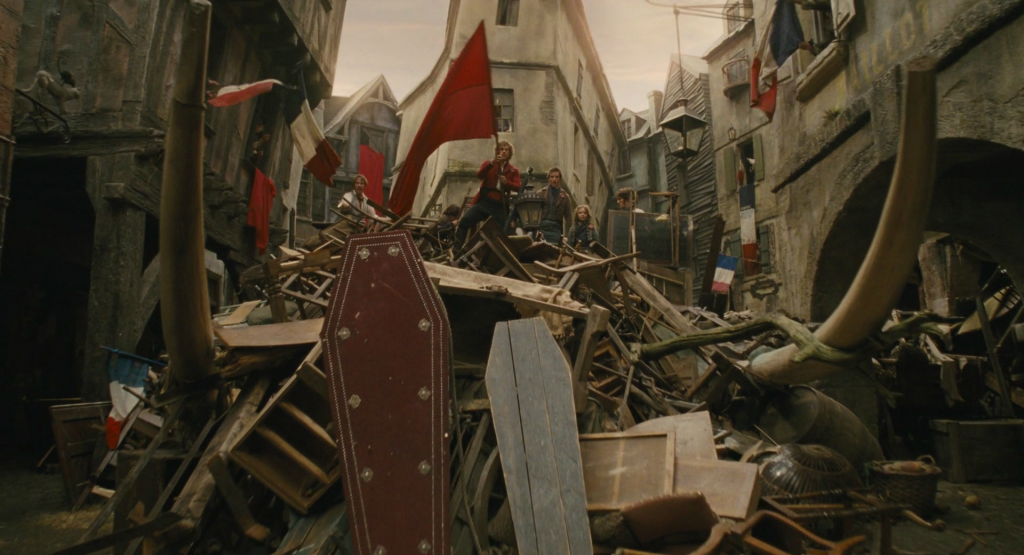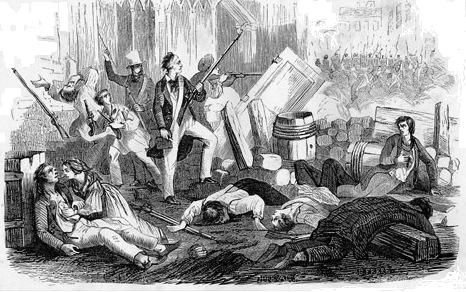The June Rebellion, also known as the Paris Uprising of 1832, took place between June 5-6, 1832. Anti-monarchist republicans in Paris began the uprising attempting to turn back the 1830 July Monarchy. During the public funeral of General Jean Maximilien Lamarque on June 5, the rebellion began. Barricades surrounding the rue Saint-Martin and rue Saint-Danis were built. This event inspired French novelist and poet, Victor Hugo, for his 1862 novel Les Misérables, depicting the aftermath of the French Revolution.
In 1830, two years prior to the rebellion, a constitutional monarchy was established by the elected Chamber of Deputies. Charles X of the House of Bourbon found himself replaced by Louis-Philippe, who possessed more liberal views than his predecessor. French republicans were angry with the new monarchy. They only saw that kings kept being replaced by new ones. Bonapartists, supporters of Napoleon Bonaparte, wanted his empire restored and those who supported the Bourbon dynasty, Legitimists, tried to find a way to place Charles X’s supposed heir, Henry, Count of Chambord, on the throne.
But before even that, France had been having economic problems for many years, especially between 1827-1832, though it had been going on since the end of the American Revolutionary War due to all the money the French spent assisting the Americans. Not only were there problems economically, but the country was also having food shortages and harvest failures, plus the cost of living was only going up, causing for an even more rigid and discontented class system.
[ebaylistings]
To make matters worse, there was an outbreak of cholera, an infection in the small intestine, during the spring of 1832 in Paris. At the end of the outbreak, over 18,402 Parisians had died and 100,000 French people outside of the city. Because the disease was especially common in the poor, poverty stricken neighborhoods, there were rumors that the government was spreading the disease by poisoning wells. Prime Minister Casimir Perier came in contact with the disease, dying on May 16, 1832. Then, General Jean Maximilien Lamarque followed on June, 1, 1832. While Perier, as Prime Minister, was given a grand state funeral, Lamarque was given a public funeral. He was especially popular with the French people as a war hero and reformer.
Even before these two well known med succumbed to Cholera and died, France had had two large and significant rebellions. Lyon, another large French city, was home to the Canut revolt. The revolt was caused by France’s economic problems in December of 1831. Workers’ wages had gone down from a drop in silk prices, mainly, leading to the first of the Canut revolts. Troops were sent to the city to try and calm the rebellion. Then in Paris, another revolt happened in February of 1832. Legitimists, also known as Carlists, who supported the Bourbon dynasty, had attempted to carry off the royal family. This rebellion is now known as the “conspiracy of rue des Prouvaires”. Caroline, Duchess of Berry, who was the mother to Charles X’s heir, Henri, led an insurrection in Vendée, the Bourbon heartland. Later that year, the Duchess was captured and stayed in prison for not quite a year, being imprisoned in November and let out in June of 1833.
At the time, republicans in Paris, and France as a whole, were led by secret societies, that were led and formed by those who most believed in French having a change in government. These secret societies began to plan riots against Charles X and his ministers that resembled those that caused the 1830 July Revolution nearly two years previously. One of the most prominent of these secret societies was the “Society of the Rights of Man”, which was led by various Republicans with Jacobin roots and formed during the July Revolution of 1830. Because the law forbade any association of over twenty people, the society was split into divisions of twenty men each, organized like its own army. Each section had its own president and vice president as well.
On June 5, 1832, General Lamarque’s public funeral was held. As a well known war hero and reformer, he was known and loved by many. Taking charge of the cortege, groups redirected the funeral to the place of the french Revolution’s start decades before during the Storming of the Bastille in 1789, the infamous Place de la Bastille.
From the aftermath of frenzy in their own countries, refugees from Poland, Italy, and Germany fled to Paris and reinforced the Parisian workers and youth that same day. Together, they gathered where Lamarque’s body was resting on the catafalque. They also made speeches, talking about how Lamarque had supported liberty for the Italians and Polish of which Lamarque had been a strong advocate of in the upcoming months to his death.
When a red flag reading “La Liberté ou la Mort”, translating into Liberty or Death, was raised, the crowd was met with an outbreak of disorder. Shots with troops from the government were exchanged as the notable Marquis de Lafayette, who was serving as a pallbearer for Lamarque, tried to calm the crowd down. Lafayette had given a speech praising Lamarque just earlier. The crowd only became more and more chaotic as outbreak spread.
About 3,000 rebels were in control of majority of the Paris’s eastern and central districts during the simultaneous uprising. For the entire night, the areas between Chatelet, the Arsenal, and the Faubourg Saint-Antoine were controlled by the insurgents. People heard cries of other rioters declaring they were going to sup that evening at Tuileries Palace. The rebellion filed to spread any further than that though.
That night, the part-time militia of the Paris National Guard, which was made up over 20,000 men, was reinforced under the command of Comte de Lobau and his 40,000 army men. The forces occupied Paris’s outer peripheral districts as the rebels made their stronghold in the historic center of the city, the Faubourg Saint-Martin. Barricades in the rue Saint-Martin and rue Saint-Denis’s narrow streets were built.
The final few rebels found themselves surrounded the next morning on June 6, 1832 at the intersection of rue Saint-Martin and rue Saint-Merry. King Louis-Philippe finally decided to make an appearance in the streets as the rebellion went on to show that he was still in control of Paris, not the rebels. He had just returned from Saint-Cloud and met with his ministers and general in Paris at Tuileries, declaring a state of siege. The king rode through the areas of the city where the uprising was most prominent as his troops applauded him.
At the Cloître Saint-Marry, they troops and rebels were faced with their final challenge. The rebels fought the French troops until that evening.
In the end, there were about 800 casualties. Of the July Monarchy’s strength of 30,000, 73 men were killed and 344 wounded. On the side of the republican rebels with a strength of only a tenth of the army’s, 3,000, 93 were killed and 291 wounded.
Afterwards, the government tried to portray the rebels as only an extremist minority. Unlike his predecessory Charles X during the July Revolution of 1830, Louis-Philippe displayed a great show of energy and courage during the short rebellion. His supporters cheered him on when he had appeared in public during and after. The foreign Minister General Sébastini had directed government forces and later stated that him and the king had been met with congratulations from local Parisians.
During the raids, the government had confiscated many weapons as people feared that the government would impose military law. At this point though, the government had been distancing itself from its past of revolutions, even though it had come to power during the French revolutions.
Michel Geoffroy, a young parisian painter, was charged with and sentenced to death for waving the red flag at Lamarque’s funeral. He was instead sent to prison after a series of legal appeals instead of being executed. It turned out he had not even been the one to raise the flag, and the true flag bearer was found later. He was only imprisoned for a month because he was unstable mentally. Of eighty-two trials, seven ended with the death sentence and the rest in imprisonment.
To try and build support for their cause, the republicans used the trials to their advantage. At their trials, many of them delivered fiery republican speeches. One of the working-class leaders of the rebellion, Charles Jeanne, was among the most notable as his defended himself and the other rebels with pride. Jeanne was imprisoned and died a few years later in 1837 while still being held in prison, becoming a martyr for the republicans. A year before his death, a pamphlet had also been published wherein the republicans and their rebellion were compared to that of the 300 Spartans heroic resistance at the Battle of Thermopylae, which had occurred well over a thousand years before in 480 BC.
Not until the French Revolution of 1848 was Louis-Philippe and his regime overthrown at last. The new government, the French Second Republic, only lasted for four years until 1852. Friedrich Engels published a pamphlet during the 1848 Revolution as well where he analyzed tactical errors made during the 1832 uprising and why it failed.
[ebaylistings]
Many people know of The June Rebellion from the famous 1862 novel Les Misérables and its musical and movie adaptation, which is one of them most well known musicals since its first performance in 1980.
Victor Hugo, who was thirty years old at the time, was in Tuileries Gardens writing a play on June 5, 1832. He heard the sounds of gunfire coming from the area of Les Halles and had to have the park-keeper let him out so he could leave the gardens. Hugo decided not to hurry back to his home and instead followed the sounds of the rebellion through Paris’s empty streets. He stumbled upon the barricades near Les Halles, unaware that much of his city had fallen into the control of the rebels for the short period of time. Hugo kept going north to rue Montmartre then towards Passage du Saumon. He ended up near rue du Bout du Monde, where he saw grilles on either side of the alleyway slammed shut. Surrounded by the many barricades, he hid himself between columns in the street where he stayed for about a quarter of an hour as the rebels and the French troops shot at each other.

Still from the 2012 movie adaptation of Les Misérables depicting the barricade built by Victor Hugo’s fictional “Friends of the ABC” based on the events of the June Rebellion.
Thirty years later, Les Misérables was published in 1862. In the novel, he depicts the rebellion and the twenty years leading up to it with his many characters, most poor and poverty stricken. Beginning when Napoleon Bonaparte is finally defeated, it ends after the June Rebellion. Parisian students, Hugo’s fictional “Friends of the ABC”, led by Enjolras, are shown planning the rebellion on the night before Lamarque’s funeral. The Friends of the ABC is described to be a subgroup of the Rights of Man Society. He describes his characters building barricades on the narrow streets of Paris in rue de la Chanvrerie and the wine shop where there operations are based. Many of the main characters of his novel are killed as they come together to fight during the June Rebellion at the barricade the built.
Before the novel, The June Rebellion was a mostly forgotten moment of history. It is one of few pieces of literature that follow the rebellion and the years and events that led up to it. And with the musical adaptation in 1980, the June Rebellion has only become more well known, as much of the musical has to do with the barricade Hugo’s characters built based on the true events of June 5, 1832.


